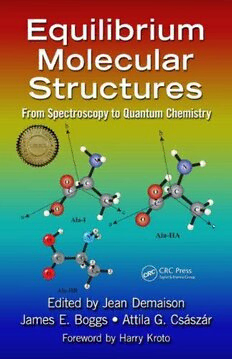
Equilibrium Molecular Structures: From Spectroscopy to Quantum Chemistry PDF
280 Pages·2010·5.016 MB·English
Most books are stored in the elastic cloud where traffic is expensive. For this reason, we have a limit on daily download.
Preview Equilibrium Molecular Structures: From Spectroscopy to Quantum Chemistry
Description:
Molecular structure is the most basic information about a substance, determining most of its properties. Determination of accurate structures is hampered in that every method applies its own definition of "structure" and thus results from different sources can yield significantly different results. Sophisticated protocols exist to account for these differences, but until now, no textbook has been written to discuss such topics in a widely accessible manner.Balancing quantum theory with practical experiments, Equilibrium Molecular Structures focuses on the theory involved in determining and converting measured and computed data sets into accurate and well-defined equilibrium structures.This textbook begins with a discussion of quantum chemistry and the concept of potential energy surfaces, quantum chemical computation of structures and anharmonic force fields. The reader is next introduced to the method of least squares and the problem of ill-conditioning, leverage points, perturbation theory, computational aspects of determining semi-experimental equilibrium structures, the determination of moments of inertia from spectra, and the treatment of resonances. The textbook also examines the determination of diatomic molecular potentials using semiclassical and quantum mechanical methods as well as position and distance averages.From basic elements to the latest advances and current best practices, Equilibrium Molecular Structures contains abundant references, examples, and exercises and includes a CD with additional examples. These features make the book ideal for class instruction but also user-friendly for self-instruction. It is recommended for newcomers to the field and also for experienced spectroscopists who want to expand their area of knowledge.
See more
The list of books you might like
Most books are stored in the elastic cloud where traffic is expensive. For this reason, we have a limit on daily download.
